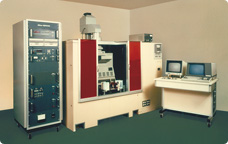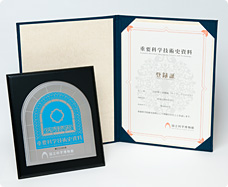
Ruling Engine No. 2
(Preserved at Nikon's Kumagaya plant)
An essential optical component in the spectroscopic analyzer, a diffraction grating consists of a glass plate or mirrored surface with fine grooves set into it and uses diffraction and interference of the light passing through it to obtain light of specific wavelengths. The machine tool used to manufacture diffraction gratings is the ruling engine.
In 1964, the first domestically manufactured ruling engine (hereafter, Ruling Engine No. 1) was completed. This was the fruit of a project by the Ministry of Education, Science and Culture (now known as the Ministry of Education, Culture, Sports, Science and Technology). In terms of precision and stability, however, this device was not good enough to be used in practice. Even in the late 1960s, the ruling engine remained a "fantasy machine" in Japan. The effort to bring this machine to reality—in the shape of the development of Ruling Engine No. 2—commenced in 1967. This is the story of Ruling Engine No. 2, with comments by Shoichiro Yoshida,* who was in charge of the development of both Ruling Engine No. 1 and Ruling Engine No. 2.
- *Shoichiro Yoshida
Joined Nikon (then known as Nippon Kogaku K. K.) in 1956. After working on development of astronomical telescopes and ruling engines, he developed IC steppers and scanners. He became president in 1997, Chairman & CEO in 2001, and from 2011 a senior counselor for Nikon.
The thinking behind Ruling Engine No. 2

Diffraction grating manufactured using Ruling Engine No. 2
In the 1960s, Nikon (then known as Nippon Kogaku K.K.) investigated the manufacture of spectroscopic analyzers as a possible new business. Within the company it was recognized that there was a need for ruling engines, as the diffraction grating is a key component of the spectroscopic analyzer.
Mr. Yoshida suggested to his superiors that Nikon develop a ruling engine in house. In view of the huge investment required, however, the response came back: "You'll have to take it up with the company president." Accompanied by the then head of the research laboratory and Tadao Tsuruta, chief researcher at the laboratory (and a former Nikon vice president), Mr. Yoshida visited the office of Hiroshi Shirahama, who served as Nippon Kogaku K.K.'s fifth and seventh presidents. In an impassioned plea to Mr. Shirahama and the directors concerned, they made the case that the ruling engine was essential to the future of the company. Although the directors assumed somewhat sour expressions, Mr. Shirahama did not reject the proposal out of hand.
Approval was then given for the development of Ruling Engine No. 2, with work commencing in 1967.
Adoption of a proven ruling method
Ruling method on Ruling Engine No. 2
During ruling, the diamond cutter repeats reciprocation, while the glass substrate moves continuously. Both movements are synchronized to maintain the accuracy of the ruling.
A ruling engine uses its diamond cutter to shave grooves into a glass plate or mirrored surface. Precise position control and drive control of the diamond cutter and the glass substrate are required in order to keep grinding the grooves dead straight and maintain the fine pitch between them. As a result, various ruling methods were considered.
Since the ruling method on Ruling Engine No. 1 was based on the fruits of a four-year program of pure research into diffraction grating ruling machines begun by the Ministry of Education, Science, Sports and Culture in 1956, it involved setting the pitch using the diamond cutter and moving the glass substrate in a reciprocating motion (back and forth). Sub-micron-level positioning accuracy was required for the diamond cutter and this was never adequately achieved on Ruling Engine No. 1.
The development of Ruling Engine No. 2 began with a literature survey. Four staff members, including Mr. Yoshida and Dr. Tsuruta, devoured all the available reference material—including old works published at around the turn of the century. Based on the lessons learnt with Ruling Engine No. 1, they selected the following ruling method.
"The pitch would be set by means of successive movements of the glass substrate and the rulings would be cut using the reciprocating motion of the diamond cutter. The movement of the diamond cutter would be monitored by an optical sensor and the movement of the glass substrate measured using a laser interferometer. The glass substrate's movement speed would then be adjusted based on the real-time positional information obtained using the optical sensor and the laser interferometer."
At the time this was a proven method that had been adopted on ruling engines developed by the greatly renowned Massachusetts Institute of Technology (MIT). MIT had established a control system that perfectly synchronized the movements of the diamond cutter and the glass substrate, and achieved high-precision ruling by this method.
Encountering world-class technology

The Nikon G-250 Monochromator
Despite the fact that the technological direction to follow had been determined, it proved extremely difficult to bring Ruling Engine No. 2 to fruition within the limited budget and timescale allowed.
In 1968, Mr. Yoshida made a business trip to the United States and had the opportunity to tour the factory of US machine toolmaker Moore Special Tools (hereafter Moore), which had manufactured MIT's ruling engines.
Mr. Yoshida describes his surprise at the time, saying "I was aware of the technological gap between Japan and the United States. However, it was astonishing to actually see world-class technology up close." In view of the budget and the delivery deadline, the decision was taken to subcontract to Moore the manufacture of basic components for Ruling Engine No. 2, such as the diamond cutter holder and the stage on which the glass substrate would be mounted.
In 1971, the basic components of Ruling Engine No. 2 were set up in a special room in the Yokohama factory. Then, the development of the control system for the mounting stage for the glass substrate—including the laser interferometer—proceeded at Nikon. Nikon also took on the development of the grinding technology for the diamond cutter and the replica production technology for the mass production of diffraction gratings.
In 1974, mass production commenced of 2-inch square diffraction gratings for installation in the Nikon G-250 monochromator, a spectroscopic analyzer. The fantasy machine had become a reality.
From ruling engines to IC steppers and scanners


NSR-1010G, the first domestically manufactured commercial Step-and-Repeat System
The successful implementation of Ruling Engine No. 2 provided a major impetus for Nikon's development of IC steppers and scanners.
In 1976, VLSI Technology Research Association commissioned Nikon to undertake development of a prototype Step-and-Repeat System (the SR-1), which the company completed in 1978. Then, in 1980, Nikon announced the release of the NSR-1010G, the first domestically manufactured commercial Step-and-Repeat System, which it began shipping in January of the following year.
Subsequently, Nikon went on to become a presence that underpinned the entire Japanese semiconductor industry, as its IC steppers and scanners eclipsed US-made equipment and came to represent a mainstay of its business.
The process of building ruling engines enabled Nikon to acquire precision machining technology and measurement control technology. As Mr. Yoshida recounts, using these technologies (along with photo-electric sensor technology and the Ultra Micro Nikkor) as the fundamental building blocks, Nikon was then able to develop the Step–and–Repeat System–a semiconductor photolithography device. Mr. Yoshida subsequently came to be known as the "father of the Japanese stepper."
Registration of an important science and technology artifact
The National Museum of Nature and Science conducts the registration of historical materials relating to key science and technology. The purpose of this is to preserve and properly utilize science and technology materials that exemplify the evolution of science and technology in Japan. In fiscal 2011, Ruling Engine No. 2 was selected for registration at the museum.
The reason cited for its selection was that "the technology of the ruling engine led on to the basic technology for semiconductor photolithography equipment, which became the cornerstone of Japanese semiconductor manufacturing technology."
Shinji Kondo, the director-general of the National Museum of Nature and Science, presented Mr. Yoshida with the certificate at a presentation ceremony held at the museum on 27 September, 2011.

Mr. Yoshida receiving a registration certificate for Essential Historical Material for Science and Technology

Registration certificate and plaque for Essential Historical Material for Science and Technology

